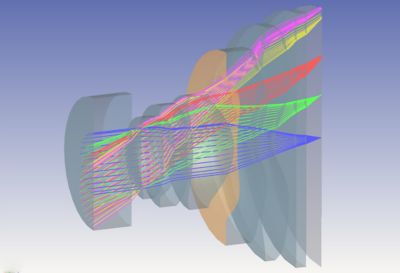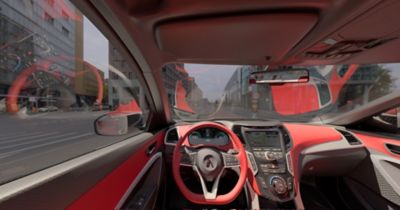-
United States -
United Kingdom -
India -
France -
Deutschland -
Italia -
日本 -
대한민국 -
中国 -
台灣
-
-
产品组合
查看所有产品Ansys致力于通过向学生提供免费的仿真工程软件来助力他们获得成功。
-
什么是光线追迹?
光线追迹(Ray Tracing)是一种计算方法,用于表示光线与物体相互作用时的行为方式。在光的波长远小于与之相互作用的物体时,光线追迹可用于仿真光的行为。
光线追迹不仅可追踪这些光线穿过不同光学及光子系统的路径,而且还可仿真光线在与不同结构进行物理交互时的折射、反射或散射方式。光线可以通过许多类型的光学系统并与之相互作用,其中许多常见物体,如反射镜、透镜或棱镜,所有这些相互作用都可以仿真。
然而,需要做出重要的区分。光线追迹涉及两个方面的光的行为。其中,最常见的光线追迹应用领域,是电子游戏。光线追迹有助于游戏开发人员通过测定物体反射光线的方式,在游戏中提供逼真的视觉效果,从而实现着色器和全局照明(为3D场景添加逼真照明的算法)的实时开发。此外,其还可帮助开发人员提供表面纹理的渲染图像。
视频游戏是实时光线追迹技术,速度是关键,游戏引擎提供高级视觉效果以及高画质图像,尽管增加的算力会降低游戏的帧速率。游戏中的光线追迹以计算机图形和渲染技术(光栅化等)为核心。
另一方面,在光学和光子学领域,光线追迹是光源与物理物体相互作用的方式,因此其考虑系统的材料属性以及发生的物理相互作用。在光学和光子学领域,光线追迹的核心是准确定和光的行为核心,而不是作为视觉写实的工具。本文重点介绍的是光线追迹在光学和光子组件设计中的应用。
光线追迹的工作原理?
光线追迹是一种计算方法,用于在光线穿过光学系统时对其进行建模。可将其用于设计透镜、传感器和其它光学组件,以便基于不同入射角的光与结构相互作用的方式来预测组件性能。光线在空气中传播并遇到另一种具有不同折射率(决定光在密度不同的两种介质界面上弯曲程度的属性)的材料时,会通过新介质折射,而有一部分则会反射。
光线穿过空气并遇到具有不同折射率(衡量材料减慢速度并使光线弯曲的程度)的材料时,会分为两个部分:一部分在进入新介质时会折射(弯曲),而另一部分则会从表面反射。根据斯涅尔定律(Snell's Law),弯曲程度取决于两种材料之间的折射率差异。例如,光线从低折射率材料(如空气)进入高折射率材料(如玻璃),会向法线弯曲。反之,进入折射率较低的材料则会使其偏离法线。
光线追踪本质上是跟踪光在不同材料和全尺度光学组件(例如透镜和衍射光栅等)中的基本物理行为。这是一种基于仿真的方法,可在系统中可视化光路径,其不仅包括观察光源附近的光是什么样子的,而且还包括检验这些光线在穿过不同材料和几何结构后是如何变化的。
总之,光线追迹是一种高效、准确的仿真方法,可支持高质量光学组件的设计。
光线追迹的应用领域
光线追迹广泛应用于光学系统仿真,特别是在系统的尺寸远远大于光的波长时。这种尺寸差异允许光线追迹将光近似为光线,而忽略其波状属性,从而可简化计算,提升仿真的速度和计算效率。
对于小于光波长的系统,光线追迹的有效性会变低,因为衍射和干涉等波动现象会占据主导地位。在这种情况下,电磁场分析(例如时域有限差分(FDTD)或严格耦合波分析(RCWA)更为合适,因为其会考虑上述影响。虽然这些方法是计算密集型的,但它们可为亚波长系统提供必要的精度,无需极高的中央处理单元(CPU)和图形处理单元(GPU)性能,便可获得基于光线的近似。

展示单个光线如何通过手机镜头传播的光线追迹仿真
光线追迹可以覆盖所有涉及光的应用,从天文学到电磁学、航空航天、国防、通信、医疗技术以及消费类电子产品。光线追迹的最大应用领域是所有涉及镜头的实际应用,从常规摄像头到手机摄像头、抬头显示器、望远镜、AR/VR头显、前照灯、内窥镜以及照明系统(医疗或建筑),不一而足。
在光学及光子设计中使用光线追迹
光线追迹可用于评估光学组件的性能并改进其设计,以满足严格的规范要求。一些评估的参数包括组件对光的聚焦程度、光源传输到图像(用于显示器)中的能量、图像颜色深度以及光学组件的对比度质量。
从组件的角度来看,从光线追迹中获得的信息可用于优化设计。利用光线追迹可以获得大量信息,其中包括:
- 镜头设计:评估透镜曲率或厚度的变化如何影响光传播和光学性能
- 制造变化:评估透镜曲率或其它生产公差的微小偏差如何影响系统性能
- 空间最大化:优化光学器件中的外壳和封装空间
- 感知的改变:了解不同角度的光线将对佩戴或观看光学设备(包括交通光线会对观看抬头显示器的驾驶员产生怎样的影响)的用户的感知产生怎样的影响
- 消除失真:识别错误光源的来源及其带来的影响
- 系统对齐:微调多个光学元件的位置和方向,以提高系统性能
- 图像质量:在显示应用中评估最终图像质量
其可以评估复杂光学系统中的所有不同的潜在光变效应以及多个镜头之间的相互作用,以了解光学系统的最终性能。光线追迹可用于构建“图像”,供工程师在实际设计组件之前查看,从而节省时间和资金。
GPU如何影响光线追迹性能
在光线追迹仿真中,光轨迹是根据一系列几何结构计算出来的。在光学系统中,数百万甚至数十亿光线将与需要仿真的组件相互作用。对于每一束光线,都需要进行数百到数千次运算,才能准确计算其穿过组件的路径,这就需要具有高计算性能的计算系统。
高端CPU有多个内核,其中最高端的CPU有多达128个内核,其可独立处理每束光线。然而,GPU(通常称为显卡)具有不同的架构,其内部的计算单元更小但更多。因此,更好的GPU可以提高光线追迹功能。
NVIDIA在2018年将RTX技术推向市场以来,GPU的功能得到了显著提升。这些GPU包含光线追迹内核(RT内核),是专门用于优化光线传播的计算单元。为光线追迹提供专用计算单元,可实现更高的性能。Ansys多年来一直使用最新的领先GPU来提供最佳性能,并使用NVIDIA RTX GPU来尽量提供领先的光线追迹仿真。
光线追迹仿真软件
Ansys具有不同的软件解决方案,可用于在不同光学组件上执行不同级别的光线追迹。主要软件解决方案有Ansys Zemax OpticStudio软件和Ansys Speos应用。
OpticStudio软件用于观察光线如何与镜头、反射镜和棱镜等单个光学组件相互作用。一旦单个光学组件完成成像后,就可以使用Ansys Speos软件对其进行全系统仿真(例如汽车内部仿真),以了解光线如何与更大系统的所有不同组件相互作用。
Speos软件可用于研究人眼在不同条件(例如白天、夜间、阴天或雪天)下对光学设备的感知情况,而且还能为该系统中的所有材料提供逼真的表面渲染效果。例如,我们可以预测,镀铬材料在挡风玻璃上的反射会如何影响驾驶员的注意力。

Ansys Speos仿真——日光照射下的汽车内饰。100Grays。现已证实,选择红色皮革和灰色哑光金属材质,可改变驾驶员的视野。

Ansys Speos仿真——夜间汽车内饰。100Grays。指示灯的反射会改变驾驶员在左后视镜上的视野。
您想了解更多信息吗?
探索光线追迹如何增强您对光学系统的了解。欢迎立即联系我们的技术团队,为您的设计获取最佳仿真方法指南。
相关资源
现在就开始行动吧!
如果您面临工程方面的挑战,我们的团队将随时为您提供帮助。我们拥有丰富的经验并秉持创新承诺,期待与您联系。让我们携手合作,将您的工程挑战转化为价值增长和成功的机遇。欢迎立即联系我们进行交流。










